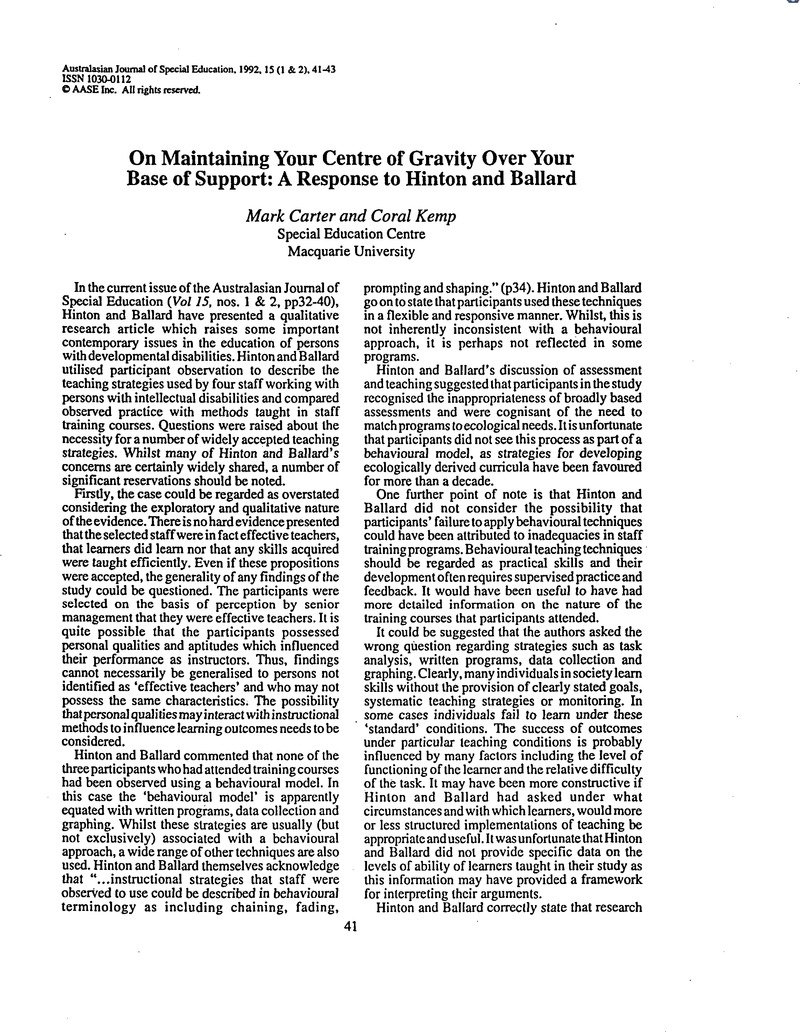No CrossRef data available.
Article contents
On Maintaining Your Centre of Gravity Over Your Base of Support: A Response to Hinton and Ballard
Published online by Cambridge University Press: 26 February 2016
Abstract
An abstract is not available for this content so a preview has been provided. Please use the Get access link above for information on how to access this content.

- Type
- Reply
- Information
- Copyright
- Copyright © The Australian Association of Special Education 1992
References
Alwell, M., Hunt, P., Goetz, L., & Sailor, W. (1989). Teaching generalized communicative behaviors within interrupted behavior chain contexts. Journal of the Association for Persons with Severe Handicaps, 14, 91–100.CrossRefGoogle Scholar
Browder, D., Demchak, M., Heller, M., & King, D. (1989). An in vivo evaluation of the use of data-based rules to guide instructional decisions. Journal of the Association for Persons with Severe Handicaps, 14, 234–240.CrossRefGoogle Scholar
Gee, K., Graham, N., Goetz, L., Oshima, G., & Yoshioka, K. (1991). Teaching students to request the continuation of routine activities by using time delay and decreasing physical assistance in the context of chain interruption. Journal of the Association for Persons with Severe Handicaps, 16, 154–167.Google Scholar
Guess, D., & Helmstetter, (1986). Skills cluster instruction and the individualized curriculum sequencing model. In Horner, R.H., Meyer, L.H., & Fredericks, H.D.B. (Eds.). Education of Learners with Severe Handicaps: Exemplary Service Strategies. Baltimore: Brookes.Google Scholar
Guess, D., & Noonan, M.J. (1982). Curricula and instructional, procedures for severely handicapped students. Focus on Exceptional Children, 14, 1–12.Google Scholar
Halle, J. (1984). Arranging the natural environment to occasion language: Giving severely language-delayed children reasons to communicate. Seminars in Speech and Language, 5, 185–197.Google Scholar
Halle, J.W. (1982). Teaching functional language to the handicapped: An integrative model for natural environment teaching techniques. Journal of the Association for Persons with Severe Handicaps, 7, 29–37.Google Scholar
Haring, N.G., Liberty, K.A., & White, O.R. (1980). Rules for data-based strategy decisions in instructional programs: Current research and instructional implications. In Sailor, W., Wilcox, B., & Brown, L. (Eds.), Methods of Instruction/or Severely Handicapped Students. Baltimore: Brookes.Google Scholar
Haring, T.G., Neetz, J.A., Lovinger, L., Peck, C. & Semmel, M.I. (1987). Effects of four modified incidental teaching procedures to create opportunities for communication. Journal of the Association for Persons with Severe Handicaps, 12, 218–226.CrossRefGoogle Scholar
Helmstetter, E., & Guess, D. (1987). Application of the individualized curriculum sequencing model to learners with severe sensory impairments. In Goetz, L., Guess, D., & Stremel-Campbell, K. (Eds.), Innovative Program Design for Individuals with Dual Sensory Impairments. Baltimore: Brookes.Google Scholar
Walters, J.M., & Siegel, L.V. (1982). Parent recording of speech production of developmentally delayed toddlers. Education and Treatment of Children, 5, 109–120.Google Scholar


